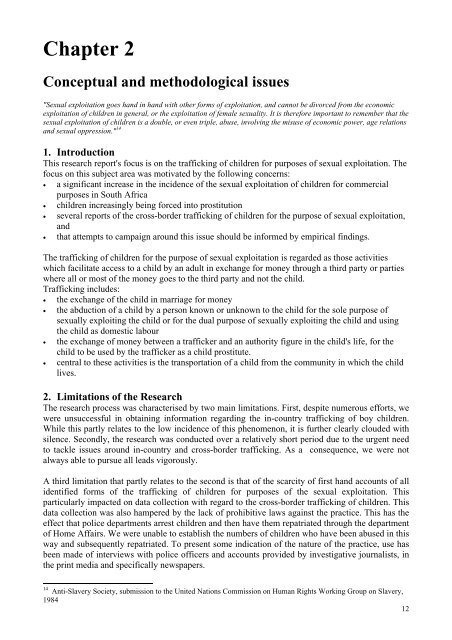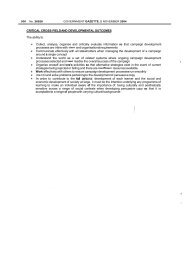The trafficking of children for purposes of sexual exploitation
The trafficking of children for purposes of sexual exploitation
The trafficking of children for purposes of sexual exploitation
Create successful ePaper yourself
Turn your PDF publications into a flip-book with our unique Google optimized e-Paper software.
Chapter 2<br />
Conceptual and methodological issues<br />
"Sexual <strong>exploitation</strong> goes hand in hand with other <strong>for</strong>ms <strong>of</strong> <strong>exploitation</strong>, and cannot be divorced from the economic<br />
<strong>exploitation</strong> <strong>of</strong> <strong>children</strong> in general, or the <strong>exploitation</strong> <strong>of</strong> female <strong>sexual</strong>ity. It is there<strong>for</strong>e important to remember that the<br />
<strong>sexual</strong> <strong>exploitation</strong> <strong>of</strong> <strong>children</strong> is a double, or even triple, abuse, involving the misuse <strong>of</strong> economic power, age relations<br />
and <strong>sexual</strong> oppression." 14<br />
1. Introduction<br />
This research report's focus is on the <strong>trafficking</strong> <strong>of</strong> <strong>children</strong> <strong>for</strong> <strong>purposes</strong> <strong>of</strong> <strong>sexual</strong> <strong>exploitation</strong>. <strong>The</strong><br />
focus on this subject area was motivated by the following concerns:<br />
• a significant increase in the incidence <strong>of</strong> the <strong>sexual</strong> <strong>exploitation</strong> <strong>of</strong> <strong>children</strong> <strong>for</strong> commercial<br />
<strong>purposes</strong> in South Africa<br />
• <strong>children</strong> increasingly being <strong>for</strong>ced into prostitution<br />
• several reports <strong>of</strong> the cross-border <strong>trafficking</strong> <strong>of</strong> <strong>children</strong> <strong>for</strong> the purpose <strong>of</strong> <strong>sexual</strong> <strong>exploitation</strong>,<br />
and<br />
• that attempts to campaign around this issue should be in<strong>for</strong>med by empirical findings.<br />
<strong>The</strong> <strong>trafficking</strong> <strong>of</strong> <strong>children</strong> <strong>for</strong> the purpose <strong>of</strong> <strong>sexual</strong> <strong>exploitation</strong> is regarded as those activities<br />
which facilitate access to a child by an adult in exchange <strong>for</strong> money through a third party or parties<br />
where all or most <strong>of</strong> the money goes to the third party and not the child.<br />
Trafficking includes:<br />
• the exchange <strong>of</strong> the child in marriage <strong>for</strong> money<br />
• the abduction <strong>of</strong> a child by a person known or unknown to the child <strong>for</strong> the sole purpose <strong>of</strong><br />
<strong>sexual</strong>ly exploiting the child or <strong>for</strong> the dual purpose <strong>of</strong> <strong>sexual</strong>ly exploiting the child and using<br />
the child as domestic labour<br />
• the exchange <strong>of</strong> money between a trafficker and an authority figure in the child's life, <strong>for</strong> the<br />
child to be used by the trafficker as a child prostitute.<br />
• central to these activities is the transportation <strong>of</strong> a child from the community in which the child<br />
lives.<br />
2. Limitations <strong>of</strong> the Research<br />
<strong>The</strong> research process was characterised by two main limitations. First, despite numerous ef<strong>for</strong>ts, we<br />
were unsuccessful in obtaining in<strong>for</strong>mation regarding the in-country <strong>trafficking</strong> <strong>of</strong> boy <strong>children</strong>.<br />
While this partly relates to the low incidence <strong>of</strong> this phenomenon, it is further clearly clouded with<br />
silence. Secondly, the research was conducted over a relatively short period due to the urgent need<br />
to tackle issues around in-country and cross-border <strong>trafficking</strong>. As a consequence, we were not<br />
always able to pursue all leads vigorously.<br />
A third limitation that partly relates to the second is that <strong>of</strong> the scarcity <strong>of</strong> first hand accounts <strong>of</strong> all<br />
identified <strong>for</strong>ms <strong>of</strong> the <strong>trafficking</strong> <strong>of</strong> <strong>children</strong> <strong>for</strong> <strong>purposes</strong> <strong>of</strong> the <strong>sexual</strong> <strong>exploitation</strong>. This<br />
particularly impacted on data collection with regard to the cross-border <strong>trafficking</strong> <strong>of</strong> <strong>children</strong>. This<br />
data collection was also hampered by the lack <strong>of</strong> prohibitive laws against the practice. This has the<br />
effect that police departments arrest <strong>children</strong> and then have them repatriated through the department<br />
<strong>of</strong> Home Affairs. We were unable to establish the numbers <strong>of</strong> <strong>children</strong> who have been abused in this<br />
way and subsequently repatriated. To present some indication <strong>of</strong> the nature <strong>of</strong> the practice, use has<br />
been made <strong>of</strong> interviews with police <strong>of</strong>ficers and accounts provided by investigative journalists, in<br />
the print media and specifically newspapers.<br />
14 Anti-Slavery Society, submission to the United Nations Commission on Human Rights Working Group on Slavery,<br />
1984<br />
12
















